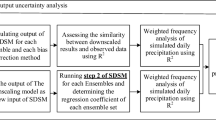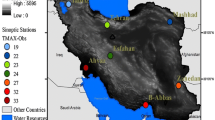Abstract
Consideration of different Statistical Downscaling (SD) models and multi-sources global climate models’ (GCMs) data can provide a better range of uncertainty for climatic and statistical indices. In this study, results of two SD models, ASD (Automated Statistical Downscaling) and SDSM (Statistical Downscaling Model), were used for uncertainty analysis of temperature and precipitation prediction under climate change impacts for two meteorological stations in Iran. Uncertainty analysis was performed based on application of two GCMs and climate scenarios (A2, A1B, A2a and B2a) for 2011–2040, 2041–2070 and 2071–2100 future time slices. A new technique based on fuzzy logic was proposed and only used to describe uncertainties associated with downscaling methods in temperature and precipitation predictions. In this technique, different membership functions were defined to fuzzify results. Based on these functions width, precipitation had higher uncertainty in comparison with the temperature which could be attributed to the complexity of temporal and local distribution of rainfall. Moreover, little width of membership functions for temperatures in both stations indicated less uncertainty in cold months, whereas the results showed more uncertainty for summer. The results of this study highlight the significance of incorporating uncertainty associated with two downscaling approaches and outputs of GCMs (CGCM3 and HadCM3) under emission scenarios A2, A1B, A2a and B2a in hydrologic modeling and future predictions.




Similar content being viewed by others
References
Abbasnia M, Tavousi T, Khosravi M (2016) Assessment of future changes in the maximum temperature at selected stations in Iran based on HADCM3 and CGCM3 models. Asia-Pac J Atmos Sci 52(4):371–377
Bae DH, Koike T, Awan JA, Lee MH, Sohn KH (2015) Climate change impact assessment on water resources and susceptible zones identification in the Asian monsoon region. Water Resour Manag 29(14):5377–5393
Brigode P, Oudin L, Perrin C (2013) Hydrological model parameter instability: a source of additional uncertainty in estimating the hydrological impacts of climate change? J Hydrol 476:410–425
Chen J, Brissette FP, Leconte R (2011) Uncertainty of downscaling method in quantifying the impact of climate change on hydrology. J Hydrol 401(3):190–202
DAI CGCM3 Predictors (2013) Sets of Predictor Variables Derived From CGCM3 T47 and NCEP/NCAR Reanalysis. Version 1.1, December 2013, Montreal, QC, Canada, 15 pp.
Dibike YB, Gachon P, St-Hilaire A, Ouarda TBMJ, Nguyen VTV (2008) Uncertainty analysis of statistically downscaled temperature and precipitation regimes in northern Canada. Theor Appl Climatol 91(1–4):149–170
Etemadi H, Samadi S, Sharifikia M (2014) Uncertainty analysis of statistical downscaling models using general circulation model over an international wetland. Clim Dyn 42(11–12):2899–2920
Gaur A, Simonovic SP (2015) Towards reducing climate change impact assessment process uncertainty. Environ Prog 2(2):275–290
Ghosh S, Katkar S (2012) Modeling uncertainty resulting from multiple downscaling methods in assessing hydrological impacts of climate change. Water Resour Manag 26(12):3559–3579
Goharian E, Burian SJ (2014) Integrated urban water resources modeling in a semi-arid mountainous region using a cyber-infrastructure framework. 11th international conference on hydroinformatics, HIC 2014, New York City, USA, City College of New York, CUNY Academic Works. http://academicworks.cuny.edu/cc_conf_hic/230
Goharian E, Burian SJ, Bardsley T, Strong C (2015) Incorporating potential severity into vulnerability assessment of water supply systems under climate change conditions. J Water Resour Plan Manag 142(2):04015051
Hessami M, Quarda TBMJ, Gachon P, St-Hailaire A, Selva F, Bobee B (2004) Evaluation of statistical downscaling method over several regions of eastern Canada, 57th Canadian water resources association annual congress.
Hessami M, Gachon P, Ouarda TB, St-Hilaire A (2008) Automated regression-based statistical downscaling tool. Environ Model Softw 23(6):813–834
Karamouz M, Nazif S, Zahmatkesh Z (2013) Self-organizing gaussian-based downscaling of climate data for simulation of urban drainage systems. J Irrig Drain Eng 139(2):98–112
Karamouz M, Zahmatkesh Z, Goharian E, Nazif S (2014) Combined impact of inland and coastal floods: mapping knowledge base for development of planning strategies. J Water Resour Plan Manag 141(8):04014098
Khan MS, Coulibaly P, Dibike Y (2006) Uncertainty analysis of statistical downscaling methods. J Hydrol 319(1):357–382
Lespinas F, Ludwig W, Heussner S (2014) Hydrological and climatic uncertainties associated with modeling the impact of climate change on water resources of small Mediterranean coastal rivers. J Hydrol 511:403–422
Najafzadeh M, Balf MR, Rashedi E (2016) Prediction of maximum scour depth around piers with debris accumulation using EPR, MT, and GEP models. Journal of Hydroinformatics, jh2016212. doi:10.2166/hydro.2016.212
Samadi S, Wilson CA, Moradkhani H (2013) Uncertainty analysis of statistical downscaling models using Hadley Centre coupled model. Theor Appl Climatol 114(3–4):673–690
Sunyer MA, Madsen H, Ang PH (2012) A comparison of different regional climate models and statistical downscaling methods for extreme rainfall estimation under climate change. Atmos Res 103:119–128
Wilby RL, Dawson CW (2007) SDSM- a decision support tool for the assessment of regional climate change impacts, user manual.
Wilby RL, Dawson CW, Barrow EM (2002) SDSM—a decision support tool for the assessment of regional climate change impacts. Environ Model Softw 17(2):145–157
Willmott CJ, Robeson SM, Matsuura K (2012) Short communication: a refined index of model performance. Int J Climatol 32(13):2088–2094
Willmott CJ, Robeson SM, Matsuura K, Ficklin DL (2015) Assessment of three dimensionless measures of model performance. Environ Model Softw 73:167–174
York C, Goharian E, Burian SJ (2015) Impacts of large-scale stormwater green infrastructure implementation and climate variability on receiving water response in the salt Lake City area. Am J Environ Sci 11(4):278
Zadeh LA (1965) Fuzzy sets. Inf Control 8(3):338–353
Zadeh LA (2005) Toward a generalized theory of uncertainty (GTU)––an outline. Inf Sci 172(1):1–40
Zahmatkesh Z, Burian SJ, Karamouz M, Tavakol-Davani H, Goharian E (2014a) Low-impact development practices to mitigate climate change effects on urban stormwater runoff: case study of New York City. J Irrig Drain Eng 141(1):04014043
Zahmatkesh Z, Karamouz M, Goharian E, Burian SJ (2014b) Analysis of the effects of climate change on urban storm water runoff using statistically downscaled precipitation data and a change factor approach. J Hydrol Eng 20(7):05014022
Zahmatkesh Z, Karamouz M, Nazif S (2015) Uncertainty based modeling of rainfall-runoff: combined differential evolution adaptive metropolis (DREAM) and K-means clustering. Adv Water Resour 83:405–420
Author information
Authors and Affiliations
Corresponding author
Rights and permissions
About this article
Cite this article
Najafi, R., Hessami Kermani, M. Uncertainty Modeling of Statistical Downscaling to Assess Climate Change Impacts on Temperature and Precipitation. Water Resour Manage 31, 1843–1858 (2017). https://doi.org/10.1007/s11269-017-1615-8
Received:
Accepted:
Published:
Issue Date:
DOI: https://doi.org/10.1007/s11269-017-1615-8




